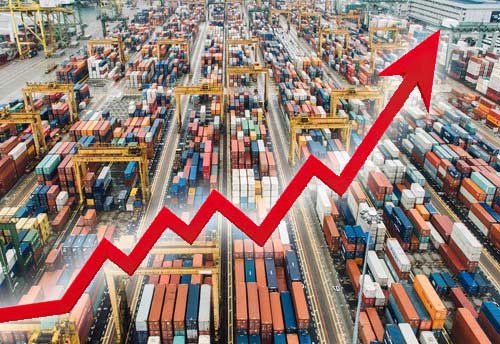
Economic Survey 2022: Exports to shoot up in ..
Jan 31 - 2022

Most of us hope that the COVID-19 pandemic will end within
months, and things will go back to normal. In fact, many aspects of our society
may never return to normal.
In an effort to control the spread of the coronavirus,
governments have taken extreme measures reserved for global wartime situations
and the use of military-grade surveillance technology to enforce social
distancing. With millions of people incomplete or partial lockdown, the
pandemic has forced societies to quickly and
dramatically change how we work,
communicate, socialize, and consume products and services.
History teaches us that short-term measures taken in
response to global crises lead to changes that last for decades. What most of
us consider normal has already fundamentally shifted. Manufacturers who
understand and act on this new normal will have ample opportunities for growth.
From Short-Term to Major Shift
In every major crisis, from the great depression to the
2007-9 financial crisis, we have witnessed the implementation of
short-term
measures that turned into fundamental social and economic shifts that lasted
for generations:
The Great Depression redefined the role of the government in
the financial system, and many people who lived through that time have pinched
pennies for the rest of their lives.
The rise of the military-industrial complex during World War
II and related financial stimuli brought about a
revival of
manufacturing
ingenuity and entrepreneurship. The U.S. became an undisputed industrial
superpower and consumerism grew rapidly.
The 9/11 Attacks exacerbated the 2001 recession, led to the
prolonged wars that followed in the Middle East, and elevated
the role of
security in the interconnected global society. Greater emphasis was put on
protecting critical national infrastructure. Many travel security,
cybersecurity and governmental surveillance measures instituted
at that time
continue to this day.
The Great Recession of 2007-09 accelerated the shift from
the “ownership economy” to the “experience
economy” and the
reliance on
off-shore production in order to remain competitive.
The COVID-19 pandemic has already accelerated a number of
consumer trends like online learning, working from home, streaming services,
video communication, and consumer goods and service deliveries—in what some are
calling the “shut-in economy.” Once a critical mass of consumers gets used to
these behaviors, they will likely remain embedded in our daily lives for years
to come.
The Pandemic’s Short-Term Effects on Manufacturers
The COVID-19 pandemic hit manufacturers in an unexpected and
unprecedented way. For the first time in modern
manufacturing history, demand,
supply, and workforce availability are affected globally at the same
time.
Some companies that provide and deliver vital goods like
personal care, paper, and pharmaceutical are struggling to meet
demand driven
by panic buying. Others are experiencing dramatic drops in demand and extreme
pressure to cut operational costs. Every major manufacturer is now experiencing
disruptions across their supply chains of parts and raw materials, driven by
what may now become recurring volatility of supply from South Asia.
Social distancing and employee safety measures put an
additional level of pressure on manufacturers, as 40%-50% of their
workforce will be unavailable to perform their functions on-site. While office
employees and knowledge workers are able to shift to remote work as the default
operating mode, most factories are simply not designed to be managed remotely
and lack the digital tools and infrastructure needed to support such
activities.
Long-Term Effects
The coronavirus pandemic presents a seminal moment for
manufacturing in North America and Western Europe.
As companies scramble to
make sense of the short-term situation, we need to look beyond the fog of uncertainty
towards possible long-term changes to the industry. Most of the trends below
already started some time ago. The current crisis will merely accelerate its
adoption:
The revival of (Automated) Domestic Manufacturing: Western
countries that have become so reliant on off-shore supplies for basic needs are
now seeing the downside of decades of off-shoring production. In an effort to
reduce the cost of everyday goods, Western manufacturing lost the ability to
produce the necessities for combating the current pandemic. Machines
account for 85% of GDP in developed nations, and we may soon see a surge of
incentive plans to bring back manufacturing
segments that are considered
critical for national resilience and sustainability. Governments are almost
certain to use domestic manufacturing as part of their plan to build up
strategic resilience in the aftermath of the current crisis.
Automation will be a key component of the effort to revive
domestic manufacturing. While previous off-shoring trends were fueled by a race
to the bottom in terms of labor and productivity costs, advances in automation
and robotics have drastically increased productivity across a number of
manufacturing processes. Many of these processes can be easily reshored and deployed domestically. Automated manufacturing will not bring back demand for
low-skilled labor, but will create new jobs and opportunities for
digitally-savvy workers.
Decoupling of Supply Chains: Supply chains are
experiencing an unprecedented level of shock, especially for manufacturers that
rely on long and inflexible supply chains from a limited set of suppliers in
South Asia. In the short-term, manufacturers are looking for ways to quickly
ensure continuity and introduce flexibility. Companies that invest in making
their supply chains dramatically more transparent, predictable, and resilient
by using a wider base of global suppliers will gain a significant advantage.
Suppliers, on the other hand, will seek to establish a more diversified client
base and more localized customers across multiple geographies. Functions,
digital tools, and processes that help manage supply chain risk, accuracy, and
flexibility will ramp up across the industry, leading to faster digitization of
supply chains. As governments and multi-nationals
seek better insights into the
complexities of supply and distribution chains for critical goods, digital
tools will help better inform policy and business decisions. Greater visibility
and coordination across the supply chain will enable better collaboration with
a wider base of suppliers, ultimately driving decoupled, highly efficient—and
more resilient—supply chains.
Data Infrastructure as a Strategic Asset: In
2017, the Economist announced that data has become the world’s most
valuable resource. The COVID-19 crisis has made having access to reliable,
real-time data an
absolute necessity for coordinating the right medical
response. In the near future, data will become an even more strategic
resource across multiple facets of business and society. For Western nations,
this will mean greater investment in data connectivity, acceleration of the
deployment of 5G networks, and a push for more valuable insights into leading
economic indicators.
For manufacturing, greater connectivity will mean the
significantly accelerated deployment of Industrial IoT, including sensing, data
visualization, remote collaboration tools, and AI-based insights across their
operations. Control-tower view of data and insights across the whole
manufacturing operation will become a standard component of running a
manufacturing organization.
Digitization as a Competitive Advantage: Following
the Great Recession, McKinsey analyzed the performance of publicly
traded companies and found that 10% were much more resilient to the crisis than
their peers. They achieved resiliency by creating financial and operational
flexibility, cutting costs, and by building
a growth foundation to capture
market opportunities at the end of the crisis. The resilient companies also
invested in software technologies that gave them greater predictability and
efficiency, resulting in a significant competitive edge.
In the past decade, advances in AI and IoT technologies have
enabled tremendous efficiencies in predictability, capacity, availability, and
flexibility of supply chain and manufacturing operations. Companies that have
embraced these technologies early are already seeing a 7% revenue growth
advantage over their peers, McKinsey found. The economic and social downturn
caused by COVID-19 will create a much deeper divide between manufacturers who
have just started to digitize and those who are much further ahead on their
digital journey.
Remote Work, Collaboration and the ‘Virtual Shift’
Manufacturing still requires people to be physically on-site. Operators run machines. Maintenance staff maintains and repairs machines. External vendors and contractors need site access to provide services and help support a significant portion of the operation. With social distancing measures in place, manufacturers may lose up to 50% of their on-site personnel.
As manufacturers face this dilemma, we will see the rapid
adoption of remote diagnostic, management, and collaboration tools. This will
result in the emergence of a “virtual shift”: a team of specialists
connected remotely and constantly online in order to guide and support the
reduced “physical shift” of onsite personnel. Enabled by real-time data,
AI-based insights, and a range of communication and collaboration tools, the
virtual shift will help digitize and scale much-needed expertise across the
organization and enable the onsite workforce to become more focused, effective,
and ultimately significantly more productive. Virtual work is not just for the
office anymore; it is a new reality that will fundamentally change the work
environment in manufacturing and help accelerate a trend towards lights-out
facilities.
History teaches us that global crises create fundamental shifts that affect government policies, consumer behavior, and industrial sectors for years to come. Manufacturers must understand which parts of our social, business, and political environment will change in the aftermath of the COVID-19 pandemic and invest accordingly to prepare for the new normal.
Artem Kroupenev is vice president of strategy at Augury,
where he oversees the company’s AI-based machine health, performance, and
digital transformation solutions. He has 12 years of experience in technology,
product, innovation, and business development, and has co-founded enterprise
companies in Israel, New York, and West Africa. Artem holds a B.A. and M.A.
from IDC Herzliya in Israel.
Source: https://www.industryweek.com/technology-and-iiot/article/21129334/what-will-manufacturings-new-normal-be-after-covid19